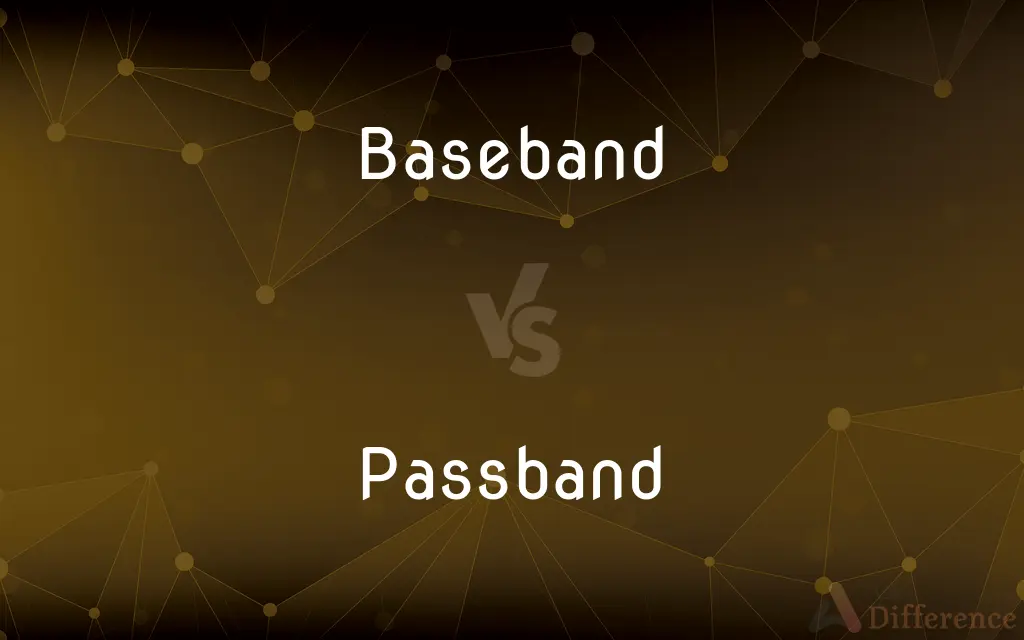Baseband vs. Passband — What's the Difference?
By Tayyaba Rehman — Updated on September 30, 2023
Baseband is the signal transmission where the signal is sent directly without modulation to its original frequency band. Passband is a range of frequencies allowed to pass through a filter, used in modulated signal transmission.

Difference Between Baseband and Passband
Table of Contents
ADVERTISEMENT
Key Differences
Baseband and Passband refer to two different types of signal transmissions in communications. Baseband transmission involves sending a signal directly over the communication medium in its original form, without changing its frequency. It is typically used in digital transmissions and local area networks, where the entire bandwidth of the cable is consumed by a single signal, limiting the medium to one channel.
In contrast, Passband transmission involves modulating the signal, converting it into a different frequency range before it's sent, allowing multiple signals to be sent simultaneously over different frequency bands. This technique enables the efficient utilization of bandwidth, with several channels being available for multiple, simultaneous transmissions, typically used in radio and telecommunications where signals are transmitted over long distances.
Baseband transmission is generally simpler and more cost-effective due to the lack of modulation and demodulation processes but is more susceptible to signal attenuation over long distances. It is ideal for short-distance communications such as those in a local area network (LAN), where the signal does not travel long distances and is not mixed with other signals.
Conversely, Passband transmission is more complex and can be more expensive due to the need for modulation and demodulation, but it is effective over long distances and in environments with multiple signals. It is crucial for telecommunications and broadcast technologies, allowing for the concurrent transmission of multiple signals over a shared medium without interference.
While Baseband offers simplicity and cost-effectiveness for short-distance, single-channel communications, Passband provides the versatility and efficiency needed for long-distance, multichannel transmissions, each serving distinct purposes in the realm of communication technologies.
ADVERTISEMENT
Comparison Chart
Transmission Type
Sends signal in its original form without modulation.
Involves modulating the signal to a different frequency band.
Bandwidth Usage
Consumes entire bandwidth of the cable.
Allows multiple signals in different bands concurrently.
Application
Ideal for short-distance, such as LANs.
Suitable for long-distance and radio transmissions.
Complexity
Simpler and more cost-effective.
More complex due to modulation and demodulation.
Signal Attenuation
More susceptible over long distances.
Effective over long distances.
Compare with Definitions
Baseband
Transmission of the original signal without frequency changes.
Ethernet cables typically use baseband transmission.
Passband
Range of frequencies allowed through a filter in modulated signal transmission.
Radio transmissions often utilize passband to send multiple signals simultaneously.
Baseband
Typically used in digital transmissions and local area networks.
Baseband transmission is fundamental to the functioning of digital local area networks.
Passband
Enables the transmission of multiple signals over different frequency bands.
Passband transmission is vital for effective bandwidth utilization in telecommunications.
Baseband
Involves higher risk of signal attenuation over longer distances.
Baseband transmissions are not suitable for long-range communications due to signal loss.
Passband
Suitable for long-distance transmissions and environments with multiple signals.
For long-range radio and telecommunication signals, passband is the preferred method.
Baseband
Utilizes the entire bandwidth of the transmission medium for a single signal.
Baseband is common in local area networks where only one signal is sent at a time.
Passband
More complex due to the need for modulation and demodulation processes.
The complexity of passband transmissions can make them more expensive to implement.
Baseband
A simpler and cost-effective form of signal transmission.
For short-distance communications, baseband is usually the preferred choice.
Passband
Essential for concurrent transmission of signals without interference.
In broadcasting, passband allows multiple channels to be transmitted without mutual disturbance.
Baseband
Baseband is a signal that has a near-zero frequency range (or, a narrow frequency "bandwidth") from close to zero hertz up to a higher cut-off frequency. An example of a baseband signal would be the audio signal output of a microphone, or a single musical note or synthesized tone.
Passband
A passband is the range of frequencies or wavelengths that can pass through a filter. For example, a radio receiver contains a bandpass filter to select the frequency of the desired radio signal out of all the radio waves picked up by its antenna.
Baseband
(telecommunications) The frequency range occupied by a message signal prior to modulation.
Passband
The range of frequencies transmitted by a bandpass filter.
Baseband
A method of transmission in which only one frequency channel is used at a time.
Passband
The range of frequencies or wavelengths that can pass through a filter without being reduced in amplitude.
Baseband
(electronics) A device using baseband transmission.
Common Curiosities
What is the purpose of Passband?
Passband allows for the transmission of multiple modulated signals over different frequency bands simultaneously.
Does Baseband use modulation?
No, Baseband sends the signal without modulation, utilizing the entire bandwidth for a single signal.
Is Baseband suitable for long-distance communications?
No, Baseband is more susceptible to signal attenuation and is ideal for short-distance communications.
Can Passband transmit multiple signals concurrently?
Yes, Passband enables the concurrent transmission of multiple signals without interference.
What is Baseband transmission?
Baseband transmission sends a signal directly in its original form without changing its frequency.
Is Baseband more cost-effective than Passband?
Generally, Baseband is simpler and more cost-effective due to the lack of modulation and demodulation processes.
Is Passband suitable for telecommunications?
Yes, Passband is suitable and widely used in telecommunications and radio transmissions.
What is a disadvantage of Baseband?
A disadvantage of Baseband is its susceptibility to signal attenuation over longer distances.
Is Passband more complex than Baseband?
Yes, Passband is more complex due to the need for modulation and demodulation processes.
Can Baseband support multiple channels?
Typically, Baseband supports only one channel as it consumes the entire bandwidth of the medium.
What type of networks typically use Baseband?
Local area networks (LANs) typically use Baseband transmission.
Does Passband require filters?
Yes, Passband transmissions use filters to allow a range of frequencies to pass through.
What kind of signal does Baseband transmit?
Baseband transmits the original signal in its original frequency range without modulation.
Can Passband improve bandwidth utilization?
Yes, Passband allows for efficient bandwidth utilization by enabling multiple signals in different bands concurrently.
Where is Passband commonly used?
Passband is commonly used in radio and telecommunications for long-distance transmissions.
Share Your Discovery

Previous Comparison
Militant vs. Terrorist
Next Comparison
Lasso vs. NooseAuthor Spotlight
Written by
Tayyaba RehmanTayyaba Rehman is a distinguished writer, currently serving as a primary contributor to askdifference.com. As a researcher in semantics and etymology, Tayyaba's passion for the complexity of languages and their distinctions has found a perfect home on the platform. Tayyaba delves into the intricacies of language, distinguishing between commonly confused words and phrases, thereby providing clarity for readers worldwide.
















































